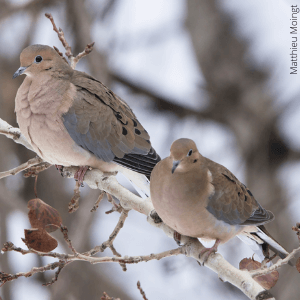There are 12 species of pigeons and doves in the United States and Canada. Some are widespread and others more localized “specialties,” occupying small ranges in the southern parts of the United States.
The main difference between pigeons and doves is not taxonomic (both are members of the Columbidae family) — but rather a linguistic one. While the word pigeon has its roots in French, dove is of Nordic origin. Although the terms “pigeon” and “dove” have no technical definition, today we tend to categorize the smaller species as doves and the larger ones as pigeons.
Contrary to public opinion, pigeons and doves are surprisingly intelligent. Studies have shown them capable of recognizing themselves in mirrors, a feat pulled off by few other non-primate species. When trained, these birds can also be taught all 26 letters of the alphabet, and even how to differentiate between different people in photographs.
Pigeons and doves face many hazards, including lead poisoning from ingesting shotgun pellets, window collisions, and habitat loss. Because Rock Pigeons are sometimes viewed as pests, they are at times directly targeted.
To help doves, pigeons, and many others, ABC employs a multipronged conservation approach that includes protecting birds from agricultural pesticides, working to decrease glass collisions, improving habitat management, and fighting against the use of lead ammunition.
Our List
For the purposes of this U.S.-based list, we've used Partners in Flight (PIF) data exclusive to the United States and Canada, which do not reflect global numbers, along with information from the Cornell Lab of Ornithology. Our taxonomic list includes all regularly occurring dove and pigeon species in the continental United States and Canada.
Rock Pigeon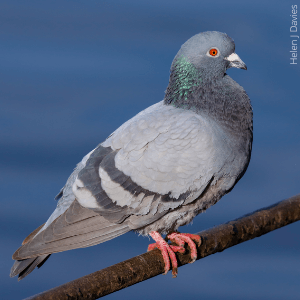
U.S./Canada Population Estimate: ~8.4 million
Population Trend: Unknown
Habitat: Urban areas, farmland, and rocky cliffs
Threats: Pesticides, window collisions, lead poisoning
Note: There is evidence in the form of carved tablets that pigeons were domesticated over 5,000 years ago. The species' original range is now impossible to determine. |
U.S. Population Estimate: <12,000
Population Trend: Decreasing
Habitat: Mangrove forests
Threats: Habitat loss due to hurricanes
Conservation Status: PIF Yellow Watchlist
Note: White-crowned Pigeons are limited in the United States to southern Florida. They nest and forage in distinct habitats, with daily flights between the two sometimes longer than 30 miles. |
Red-billed Pigeon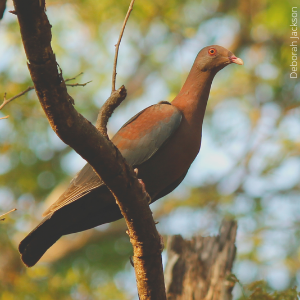 U.S. Population Estimate: <500
Population Trend: Unknown
Habitat: Tropical forests, river woodlands, tall brush
Threats: Habitat loss, lead poisoning
Note: A common bird in Mexico and Central America, this pigeon's U.S. range is confined to southern Texas. |
Band-tailed Pigeon
U.S./Canada Population Estimate: 1.4 million
Population Trend: Decreasing
Habitat: Western forest
Threats: Lead poisoning, habitat loss
Conservation Status: PIF Yellow Watchlist
Note: There are two distinct breeding populations of Band-tailed Pigeons in the United States; one along the West Coast and one in the Southwest. Band-tailed populations have declined by 57 percent in the last 50 years. |
Eurasian Collared-Dove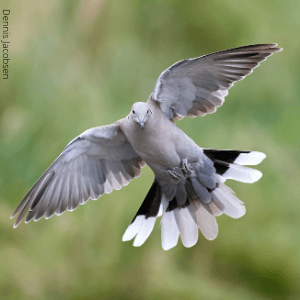
U.S./Canada Population Estimate: 400,000
Population Trend: Increasing
Habitat: Urban/suburban settings and open sites where seed is available
Threats: Vehicle collisions, glass collisions, lead poisoning
Note: Eurasian Collared-Doves arrived in North America via the Bahamas, after several dozen birds “flew the coop” from a pigeon breeder during the mid-1970s. |
Spotted Dove
U.S. Population Estimate: Very small; dwindling
Population Trend: Decreasing
Habitat: Residential areas, parks, river woods
Threats: Wildfires, habitat loss
Note: Native to Asia, where it remains common, the Spotted Dove was introduced into the Los Angeles area in the early 20th century. It gradually spread to other parts of southern California, but in recent years its numbers have declined sharply. |
Inca Dove U.S. Population Estimate: 710,000
Population Trend: Increasing
Habitat: Desert scrub and suburbs
Threats: Vehicle collisions, glass collisions, pesticides
Note: When temperatures drop below 20 degrees Fahrenheit, Inca Doves will gather together for warmth, sometimes even on top of each other, in what is called “pyramid roosting.” |
Common Ground-Dove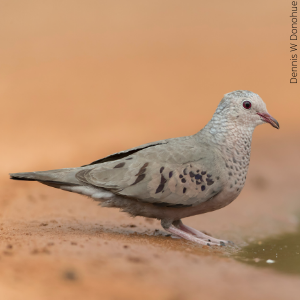
U.S. Population Estimate: 2.1 million
Population Trend: Unknown
Habitat: Desert scrub and dense brush
Threats: Predation, habitat loss, vehicle collisions
Note: The sparrow-sized Common Ground-Dove is one of the smallest doves in North America. |
Ruddy Ground-Dove U.S. Population Estimate: Unknown; a few reported each year
Population Trend: Unknown
Habitat: Urban and suburban areas, open and semi-open areas
Threats: Pesticides, vehicle strikes, predation
Note: Ruddy Ground-Doves have been spotted from southern California to southern Texas, often with Inca Doves and Common Ground-Doves. |
White-tipped Dove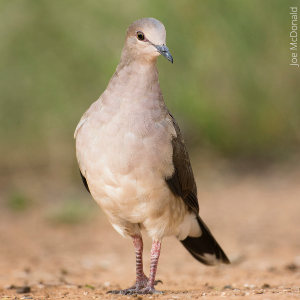
U.S. Population Estimate: <10,000
Population Trend: Unknown
Habitat: Tropical dry forests, dense low growth
Threats: Habitat loss, lead poisoning
Note: White-tipped Doves are widespread in the tropics, but their range extends north to southern Texas; they are very rarely seen in southern Arizona. |
White-winged Dove 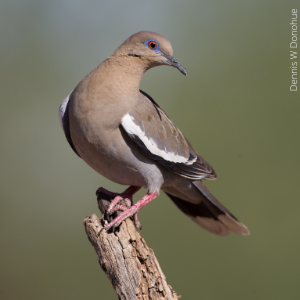 U.S. Population Estimate: 6 million
Population Trend: Increasing
Habitat: Desert shrub, orchards, suburbs
Threats: Lead poisoning, habitat loss, car strikes, glass collisions
Note: In areas where White-winged Doves live near Saguaro cacti, the timing of the birds' migration and nesting correlates with this important food plant's fruiting schedule. |
U.S./Canada Population Estimate: 130 million
Population Trend: Decreasing
Habitat: Open forest, urban/suburban areas
Threats: Lead poisoning
Note: Each day, on average, a Mourning Dove consumes 12 to 20 percent of its weight, mostly in seeds! |
How Can I Help?
We all can do our part to protect North America's pigeons and doves.
American Bird Conservancy and our Joint Venture partners have improved conservation management on 6.4 million acres of U.S. bird habitat — an area larger than the state of Maryland — over the last ten years. This is a monumental undertaking, requiring the support of many, and you can help by making a gift today.
Policies enacted by Congress and federal agencies, such as the U.S. Fish and Wildlife Service, have a huge impact on America's birds. You can help shape these rules for the better by telling lawmakers to prioritize birds, bird habitat, and bird-friendly measures. To get started, visit ABC's Action Center.
Finally, don't overlook the impact you can have at home. Living a bird-friendly life can have an immediate impact on the birds around you. Doing so can be as easy as adding native plants to your garden, avoiding pesticides, and keeping cats indoors. To learn more, visit our Bird-Friendly Life page.
 | Kathryn Stonich teaches English for the Community College of Baltimore County and Bryant & Stratton College online. She is an avid backyard birder and advocate for pigeon and dove rescue. |

















































